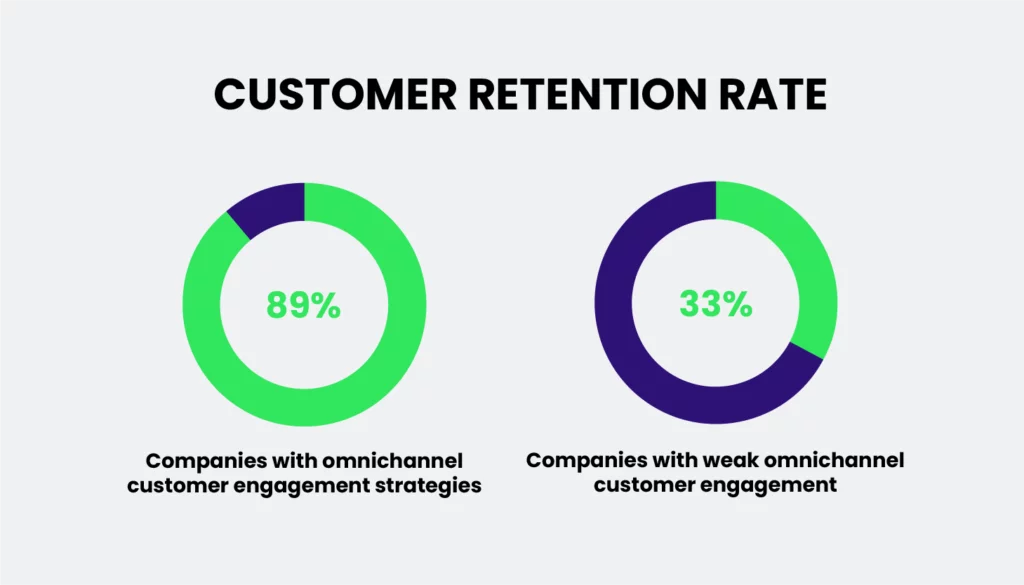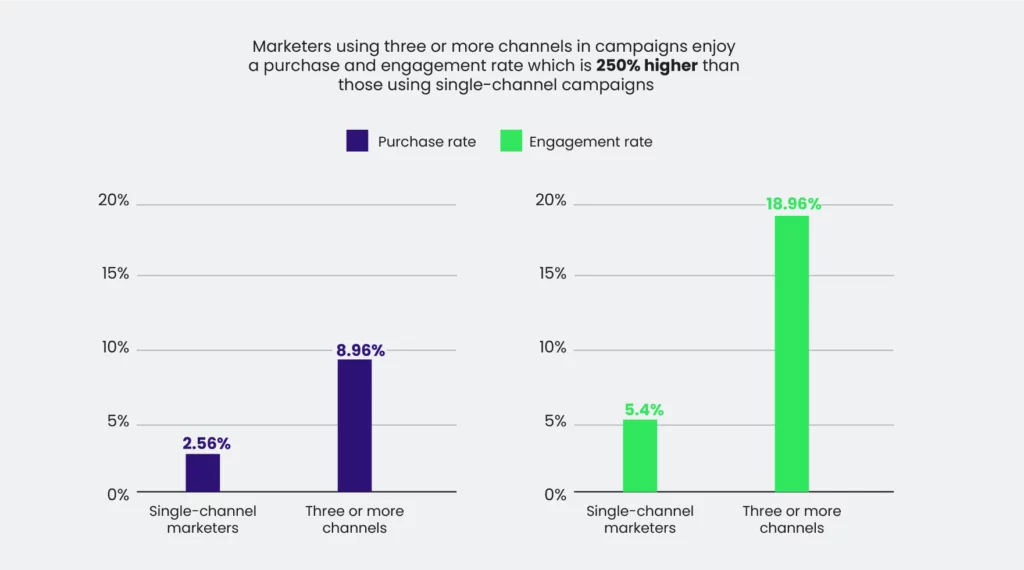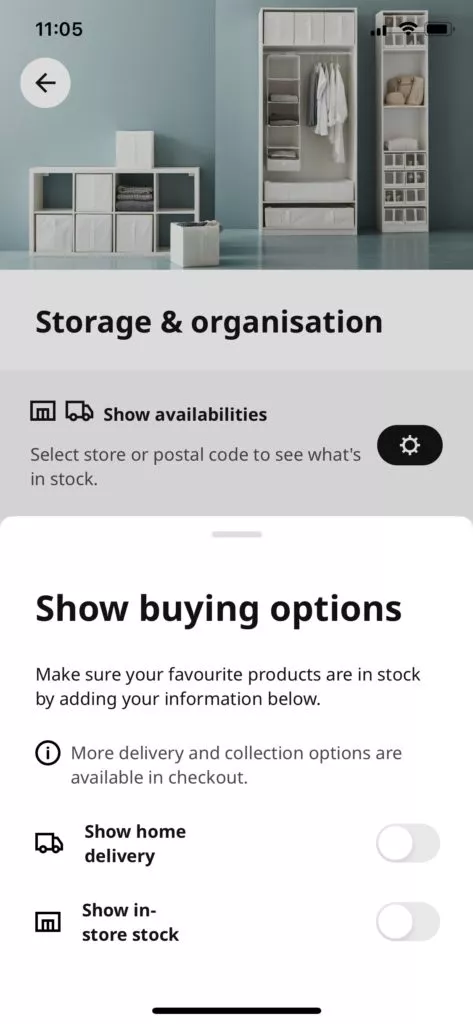Shopify attests that businesses embracing an omnichannel commerce strategy witness a remarkable upswing. On average, those venturing across online marketplaces, mobile, social media, and physical locations enjoy a staggering 190% surge in revenue – a game-changer for the bottom line.
However, despite these compelling statistics, why does omnichannel commerce still need to be discovered for many retail businesses, and what does it exactly entail?
Understanding Omnichannel Commerce:
Omnichannel commerce is a strategic approach that retailers and ecommerce businesses adopt to ensure a seamless and consistent customer experience across every touchpoint. Whether engaging in-store, through an online platform, marketplace, social media, or a mobile app, the brand experience remains cohesive.
Crucially, all channels openly share data, creating a personalized experience based on real-time customer information. Building an omnichannel strategy for physical retailers delving into ecommerce presents challenges such as online order fulfillment, fraud prevention, and SEO.
Both physical and ecommerce retailers face a common question: How can they leverage all channels to provide an excellent, consistent experience at every customer touchpoint?
Multichannel vs. Omnichannel Commerce: Deciphering the Distinction
While most brands, whether originating as brick-and-mortar or ecommerce, interact with customers across multiple channels, the terms multichannel and omnichannel are different.
Multichannel commerce operates in silos, with different promotional channels that do not interact seamlessly. On the other hand, Omnichannel commerce actively utilizes information from each channel to construct a comprehensive ecommerce strategy centered around the customer journey. The essential advantage lies in consistent and highly personalized brand messaging, facilitating seamless channel transitions and improving conversion rates.
In essence, omnichannel commerce ensures that when customers engage with various channels – Instagram, a mobile app, or an in-store visit – data collected from these interactions collaboratively nudges them toward desired actions.
The Omnichannel Commerce Customer Journey: An Example

A staggering 73% of customers traverse multiple channels before making a purchase, and it typically takes between six to eight touchpoints before a prospect converts. Consider a customer journey example for a potential omnichannel customer:
- Discovering a product online through a TikTok video.
- Explores the brand’s Instagram page and signs up for the newsletter for a new customer discount.
- Engages with retargeted Instagram ads for the discovered product.
- Conducts further research on the brand’s website, comparing pricing and features.
- M makes the final purchase in-store due to a desire for a sensory experience.
- The sales associate, armed with knowledge from online interactions, offers a personalized discount.
Benefits of Omnichannel Marketing Strategy:

- Seamless Customer Experience: Omnichannel commerce provides a unified and consistent customer experience across various channels, including online and offline platforms. This seamless integration ensures that customers can transition effortlessly between channels, creating a cohesive and satisfying journey.
- Enhanced Customer Insights: By integrating multiple channels, businesses gain a comprehensive view of customer behavior and preferences. This valuable insight allows for more targeted marketing strategies, personalized communication, and the ability to anticipate customer needs.
- Increased Customer Loyalty: Consistent and personalized interactions foster customer loyalty. Omnichannel strategies enable businesses to build stronger relationships with customers by providing a tailored experience that aligns with their preferences and habits.
- Efficient Inventory Management: Omnichannel commerce facilitates real-time inventory tracking and management. Businesses can optimize their stock levels and prevent stockouts by seamlessly coordinating inventory across various channels. This leads to improved operational efficiency and reduced costs.
- Flexibility for Customers: Omnichannel allows customers the flexibility to choose their preferred purchasing and communication channels. Whether it’s online shopping, in-store visits, or mobile interactions, customers can engage with the brand in a way that suits their preferences and lifestyle.
- Adaptability to Market Trends: As consumer behaviors evolve, omnichannel strategies enable businesses to adapt to emerging market trends quickly. This agility is crucial for staying competitive in a dynamic business landscape.
- Optimized Marketing Campaigns: With a holistic view of customer data, businesses can tailor marketing campaigns more effectively. This personalization ensures that promotional efforts are relevant to individual customer segments, leading to higher engagement and conversion rates.
- Improved Customer Service: Omnichannel commerce allows for integrated customer service across multiple channels. Businesses can provide consistent and timely support, whether it’s through live chat, social media, or traditional customer service channels, resulting in enhanced customer satisfaction.
- Data-Driven Decision-Making: The wealth of data collected from various channels empowers businesses to make informed decisions. Analyzing customer behavior, preferences, and sales data enables data-driven strategies that contribute to the overall success of the business.
- Competitive Advantage: Adopting omnichannel commerce positions businesses as forward-thinking and customer-centric. This can serve as a competitive advantage, attracting and retaining customers who value a seamless and integrated shopping experience.
Learn about omnichannel marketing tools for ecommerce here.
Strategies for Omnichannel Marketing:
1. Consistent Branding and Aesthetic
In omnichannel strategy, maintaining a consistent brand aesthetic across online and offline channels is paramount for a seamless customer experience. A notable example is the tech giant Apple, which has mastered the art of emphasizing its brand aesthetic in physical retail spaces and its ecommerce site.

Apple’s Approach:
- Minimalist Design: Apple stores are characterized by a minimalist design devoid of clutter or unnecessary decor. This intentional choice directs the spotlight onto the product assortment, creating a focused, immersive shopping environment.
- Interactivity and Spacing: The setup and spacing of tables in Apple stores are designed to encourage customers to interact with products. There’s ample room for customers to explore without feeling rushed, fostering a sense of engagement.
- Commitment to Sustainability: In recent years, Apple has integrated earthy and organic materials into newer store designs, underscoring its commitment to sustainability. This reflects the company’s dedication to using recycled materials and clean energy, with a bold vision to make all products carbon-neutral by 2030.
Guidance for Retailers:
- Unified Customer Experience: Retailers venturing into ecommerce should consider elements that create a unified customer experience. Reflect on what design elements can translate well from physical stores to online.
- Color and Design Consistency: Using similar colors and crafting a consistent look and feel across channels is crucial. This approach ensures that each channel feels like a natural extension of the other, avoiding conflicting and contrasting spaces.
2. Growing Online Traffic with SEO
Building an ecommerce presence requires a strategic focus on search engine optimization to drive organic traffic. A robust SEO strategy is instrumental in gaining online visibility regardless of the business size. Let’s explore how the sporting goods brand Stanley optimizes product descriptions for SEO.
Stanley’s SEO Excellence:

- Keyword Optimization: Stanley strategically optimizes its product descriptions on platforms like Amazon with relevant keywords. This optimization aids search engines, notably Google, understand the product’s relevance to user searches.
- Informative Descriptions: The product listing goes beyond simple descriptions, providing detailed information about materials used and critical benefits. This comprehensive approach enhances the product’s online visibility.
- Situational Use Promotion: Stanley promotes the versatility of its products, such as the travel-friendly design suitable for various situations like home, office, and car use. This strategy caters to diverse consumer needs.
Guidance for Retailers:
- Keyword Research: Conduct thorough keyword research relevant to your niche and product assortment. Implement these keywords across your website and social media platforms to enhance online visibility.
- Detailed Product Descriptions: In the ecommerce realm, where visual merchandising is limited, leverage descriptive words in product listings. This aids potential customers in finding products more efficiently.
3. Leveraging Analytics from Social Platforms for Trending Products
The evolution of platforms like TikTok has transformed into a valuable tool for retailers to identify and leverage trending products. Canada’s largest book retailer, Indigo, has adeptly harnessed the power of TikTok to boost sales and enhance customer engagement.
Indigo’s Strategic Use of TikTok:

- Tapping into #BookTok: Indigo capitalizes on TikTok’s #BookTok phenomenon, where users share reviews, ratings, and book recommendations. The retailer strategically reserves retail shelf space for books “Trending on TikTok.”
- TikTok Recommendations Page: Indigo establishes a TikTok recommendations page on its website, providing visitors with curated book suggestions. This aligns with the audience’s interest in discovering viral reads.
- Partnership and Book Club: Indigo formally partners with TikTok, launching the #BookTok Book Club. This initiative spotlights authors and books on the app, driving sales in physical stores and through the ecommerce site.
Guidance for Retailers:
- Stay Current with Trends: Identify and leverage fast-growing hashtags or trends on platforms relevant to your target audience. This dynamic approach ensures visibility and engagement with the audience.
- Strategic Partnerships: Form partnerships with social media platforms to enhance visibility. The collaboration with TikTok allows Indigo to stay agile in reserving space for trending reads.
4. Faster Order Fulfillment
Enhancing the customer buying experience involves seamless information sharing between online and offline stores. Dynamic inventory management systems facilitate quicker order fulfillment, ensuring no sales opportunities are missed due to stock unavailability.
Efficient Omnichannel Fulfillment:
- Swift Product Access: In cases of product unavailability in one channel, omnichannel fulfillment allows customers to access products swiftly through alternative channels.
- In-Store Assistance: A customer seeking a specific product that’s out of stock can be assisted by retail staff. They can locate the product in another store, offering the choice of self-pickup or direct delivery to the customer.
- Ecommerce Presence Synergy: For stores with an existing ecommerce presence, retail staff can seamlessly order online-only products if physical stock is low. This ensures a smooth shopping experience for customers.
Guidance for Retailers:
- Implement Omnichannel Systems: Invest in dynamic inventory management systems that synchronize data between online and offline channels. This ensures real-time visibility and accessibility for customers.
- Seamless Customer Support: Train retail staff to provide assistance and facilitate orders seamlessly, bridging the gap between online and offline inventory.
5. Investing in Cybersecurity
In the ever-evolving landscape of ecommerce, safeguarding customer information from cyber threats is imperative. Cybersecurity measures, such as implementing SSL certificates, are pivotal in preventing fraud and securing customer data during online transactions.
SSL Certificates for Secure Transactions:

- Identity Theft Prevention: SSL certificates ensure the encryption of data exchanged during online transactions, mitigating the risk of information interception by hackers. This is particularly crucial for preventing identity theft and instilling confidence in customers.
- Transparency and Trust: Companies that are transparent about their cybersecurity measures gain higher conversion rates. Communicating openly about the software and tools used to secure transactions fosters customer trust, leading to improved SEO rankings.
Guidance for Retailers:
- Prioritize SSL Implementation: Ensure your ecommerce site is equipped with SSL certificates to encrypt sensitive information during customer transactions. This not only enhances security but also contributes to a positive customer perception.
- Transparency Builds Trust: Communicate your cybersecurity measures transparently on your website, emphasizing your commitment to customer data privacy. This transparency can serve as a competitive advantage.
6. Diversify Delivery Options
As the lines between ecommerce and retail blur, providing diverse delivery options becomes a key strategy. Brands like IKEA excel in offering flexible delivery methods, allowing customers to choose options that align with their preferences and convenience.
IKEA’s Diverse Delivery Options:

- In-Store Pickup and Returns: IKEA allows customers to purchase online and pick up orders in-store or vice versa, depending on stock availability. This flexibility extends to returns, providing a convenient solution for customers, especially for larger items like furniture.
- Ship to Store or Pickup Point: Customers can opt to have products shipped directly to them, picked up in-store, or at a nearby pickup point. This not only enhances convenience but also contributes to customer loyalty.
Guidance for Retailers:
- Customer-Centric Delivery: Prioritize delivery options based on customer convenience. Offer a range of choices, such as in-store pickup, home delivery, or third-party pickup points.
- Communication is Key: Communicate delivery options during the checkout process. Provide real-time tracking and notifications to keep customers informed about the status of their orders.
7. Take Advantage of Your Strongest Channel
For retailers transitioning to ecommerce, leveraging existing foot traffic in physical stores to drive online traffic is a strategic move. Incorporating this seamlessly into visual merchandising and in-store communication can yield significant benefits.
Strategies for Channel Synergy:
- Front-of-Store Displays: Highlight products trending online at the front of the physical store. This draws attention to your ecommerce store or social channels, encouraging customers to explore more online.
- QR Codes for Connectivity: Place QR codes strategically throughout the store for customers seeking additional product information or wanting to connect online. This simple and effective method signals the availability of alternative channels.
- Incentivize Social Media Engagement: Use shelf talkers to incentivize social media engagement. Offer discounts or gifts for customers who follow your brand on social media, creating a seamless connection between the physical and digital realms.
Guidance for Retailers:
- Strategic Placement: Strategically place promotional materials that guide customers to your online channels. Leverage both digital and physical spaces to create a seamless customer journey.
- Customer Incentives: Incentivize customers to engage with your brand, fostering a sense of community and connectivity beyond the physical store.
8. Create Immersive Online Experiences that are Pandemic-Proof
In a world where in-person events face uncertainties, creating immersive online experiences becomes crucial. As seen in Sephora’s strategic approach, encouraging customers to share their experiences through branded hashtags amplifies social buzz.
Sephora’s Virtual Beauty House:

- Adaptability to Online Platforms: Sephora transitioned its annual in-store event into a virtual beauty house, catering to the shift in consumer behavior. This online event retained the exclusivity and engagement of the in-store counterpart.
- Interactive Virtual Rooms: Guests could navigate virtual rooms showcasing different brands and products, creating a game-like environment. QR codes facilitated virtual photo booths and offered exclusive discounts, encouraging participant interaction.
Guidance for Retailers:
- Social Sharing Opportunities: Create experiences that prompt customers to share their participation on social media. Branded hashtags and interactive elements encourage user-generated content.
- Adaptable Events: In uncertain times, pivot in-store events to online platforms. Offer exclusive content, interactive features, and rewards to replicate the immersive experience customers would find in a physical store.
9. Grow Other Channels
Expanding beyond ecommerce and retail, retailers should actively promote other channels like newsletters, SMS marketing, and mobile apps. Starbucks’ successful mobile app launch, driven by strategic incentives, is a notable example.
Starbucks’ Mobile App Strategy:

- Incentivized Downloads: Starbucks accelerated mobile app downloads by offering free wifi. This strategic move allowed them to encourage customers to opt-in for email communication and join the rewards program.
- Personalization and Rewards: The app offers customization of drinks, aligning with the in-store experience. Push notifications with special offers, games for free products, and a loyalty program contribute to its success.
Guidance for Retailers:
- Multi-Channel Engagement: Encourage customers to explore other channels such as newsletters, SMS, and mobile apps. Offer incentives for opting in and actively engaging with these channels.
- Loyalty Programs: Implement loyalty programs within mobile apps to reward customers for continued engagement. Tailor perks for top-spending customers to enhance their loyalty and overall satisfaction.
Conclusion:
A pivotal element in successful omnichannel commerce is establishing a centralized data source. This serves as a crucial safeguard against misinformation and errors. Once your channels are seamlessly synchronized, facilitating the free flow of information between platforms, you gain a comprehensive understanding of the customer journey. This insight extends to how customers navigate and interact across various mediums.
Upon completion of their customer journey and a successful purchase, a treasure trove of data from diverse channels becomes available. This data can be harnessed strategically to encourage repeat purchases and foster customer loyalty.
FAQs on Omnichannel Marketing:
Why is a central data source important in omnichannel commerce?
A central data source ensures that information is accurate and consistent across all channels, reducing the risk of misinformation or errors. It forms the foundation for a unified view of customer interactions.
What challenges might businesses face when adopting omnichannel marketing?
Challenges can include technical hurdles in integrating systems, maintaining consistent messaging, and ensuring a seamless customer journey. Overcoming these challenges requires careful planning and ongoing optimization.
How does omnichannel marketing contribute to customer loyalty?
Omnichannel strategies build customer loyalty by providing a consistent and personalized experience. Customers who have positive interactions across channels are more likely to become repeat buyers and brand advocates.
Can small businesses implement effective omnichannel marketing strategies?
Yes, small businesses can adopt omnichannel strategies by starting with key channels, focusing on data integration, and gradually expanding their approach as they grow.



